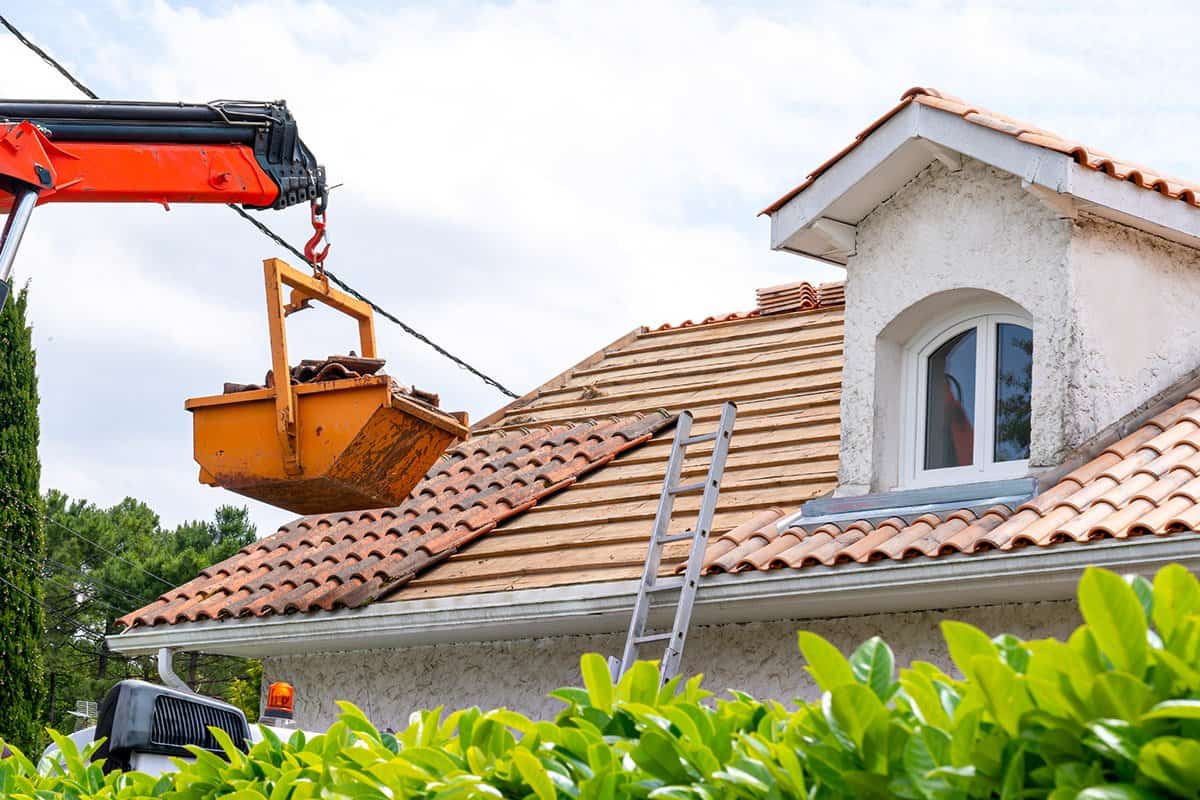When the storm rolls away and you’re left staring at a damaged roof, it’s easy to feel overwhelmed. You’ve heard stories of complicated insurance claims and hefty costs, making the prospect of dealing with this daunting task seem like a nightmare waiting to happen. But don’t worry! This guide is here to help you navigate through each step of filing an insurance claim for your roof damage.
Let’s face it – no one likes dealing with paperwork or negotiating with adjusters. It can be confusing, time-consuming, and downright stressful. But what if I told you that understanding the ins and outs of this process could make things so much easier?
In this comprehensive guide, we’ll go over how to accurately assess the situation after a storm, properly document any damage, communicate effectively with your policy provider and more.
So buckle up, because we’re about to delve into the world of home insurance claims for roof damage.
Assessing the Situation After a Storm
After a storm’s passed, you’ll need to don your detective hat and assess the situation carefully, checking for any missing shingles or visible damage that could be a tell-tale sign of roof trouble. Look with purpose and precision, my friend – this isn’t just about scanning from ground level.
Grab those binoculars, climb that ladder if it’s safe to do so, because sometimes the smallest hint of damage can lead to bigger issues down the line. Keep an eye out for dented gutters or flashing as well – they’re often clues to more extensive harm.
Now let’s not forget about the inside of your home either! After you’ve finished surveying your roof, take some time to inspect each room in your house meticulously. Are there water stains on ceilings or walls? Do you see any peeling paint or warped wood? These are signs that water may have intruded into your home during the storm.
Remember, catching these early warnings can save you bundles in future repair costs and hassle. You’ve got this; together we’ll navigate these murky post-storm waters with confidence and ease!

Documenting the Extent of the Damage
Prior to contacting your policy provider, it’s imperative that you meticulously document the full extent of your property’s devastation. Start by stepping outside and giving your home a thorough once-over with an eye for detail. Look not only at the roof but also at surrounding structures like gutters, windows, or siding which may have been impacted as well. Snap pictures of everything – every crack, missing shingle, broken tile – every hint of damage is crucial evidence in your claim process.
Remember to write down specific details about what you see; timestamps and descriptions can be real game-changers when it comes time to hash things out with the insurance company.
Now take a moment and breathe deep – this isn’t a race against time but rather a methodical process designed to cover all bases. After capturing these initial images and jotting down notes about visible damage, move inside your home and do the same there. Be meticulous in checking for signs of leaks or water damage stemming from a compromised roof structure. Don’t forget those less obvious spaces like attics or upper story rooms – they often bear the brunt of roofing woes!
Keep up this spirit of determination because every bit of evidence strengthens your case when filing an insurance claim for roof damage.
Contacting Your Policy Provider
Once you’ve gathered all your evidence, it’s time to get in touch with your policy provider. Remember, they’re not just a faceless corporation; they’re people too, eager to help you out in times like these. So don’t hesitate to ring them up or shoot them an email detailing the situation.
Be thorough and concise with the information about your roof damage and the evidence you’ve collected. This isn’t just about getting what’s owed to you; it’s also about fostering trust and maintaining a good relationship with your insurer.
Your words bear weight here, so use them wisely! Ensure that every detail of your claim is accurate and transparent. You want to paint a clear picture for your insurance company of what happened so there are no grey areas or misunderstandings that could lead to complications down the line.
After all, we’re talking about one of the most vital parts of your home: its protective shell against Mother Nature’s elements! So be bold but fair in delivering your claims because this isn’t just business—it’s personal, too.
Hiring a Professional for a Roof Inspection
It’s time to call in the big guns—a seasoned pro who knows every nook and cranny of your house’s crowning glory. That’s right, it’s high time you hire a professional for a thorough roof inspection.
These experts can spot even the smallest signs of damage that you may have overlooked or didn’t recognize. They’ve got an eagle eye for things like missing shingles, small leaks, or damaged flashing. Sure, it might cost you a bit out of pocket initially, but think about how much money it could potentially save you in the long run! You wouldn’t want to claim insurance on something minor only to find out later there was major hidden damage.
Choosing the right professional is key here—someone with experience and knowledge specific to your type of roofing material. Ask around—neighbors, friends, family—for recommendations on reliable inspectors they’ve used before. Check their reviews online and make sure they’re licensed and insured for work in your area.
This isn’t just about getting an insurance claim sorted—it’s about safeguarding what protects you from the elements day in and day out: your beloved home sweet home.
Filing the Necessary Paperwork

Now that you’ve had a professional inspect your dwelling, filing the necessary paperwork is your next step. This might seem like a daunting task, but don’t worry, we’re in this together.
First things first, gather all the documentation from the roofing contractor: the inspection report, photos of the damage, and estimates for repair or replacement. These documents are vital as they provide evidence of the damage to your roof and its impact on your home.
Next up is contacting your insurance company. Ideally, you’ll want to do this soon after receiving your inspection reports. Prompt action shows them that you’re serious about maintaining your home’s health and could expedite their processing time.
While on call with them, ask about their claim filing process; most companies will require an ‘Insurance Claim’ form filled out by you or may have an online procedure in place for convenience. Remember to be thorough when filling out these forms; every detail counts!
You can smile knowing that taking these steps brings you closer to restoring not just your roof but also peace of mind in knowing that you’ve done everything right to protect what matters most – home sweet home!
Negotiating with the Adjuster
Getting the paperwork sorted is a big step, but you’re not out of the woods just yet – next up, you’ve got to negotiate with the adjuster. You might be thinking, ‘Negotiate? Isn’t their job to look out for me?’
While it’s true that adjusters are there to assess damage and determine compensation, remember they work for the insurance company. It’s their goal to minimize payouts whenever possible. But don’t let this intimidate you! With some knowledge and preparation on your side, you can confidently navigate this part of the process.
As you approach these negotiations, think of yourself as an advocate for your home – because that’s exactly what you are! Make sure to have your contractor or a roofing expert by your side during this meeting if possible; their expertise will be invaluable when disputing any low estimates provided by the adjuster.
Don’t shy away from asking questions or requesting clarifications about anything that seems unclear. After all, it’s your roof and your money at stake here! Remember: patience and persistence often pay off in this stage of an insurance claim process.
Repairing or Replacing Your Roof
Once you’ve successfully navigated the negotiation stage, you’ll find yourself facing the next critical decision: should you repair or replace your damaged rooftop? It’s not always an easy choice. I know it feels overwhelming, and trust me, I’ve been there.
You’re thinking about cost efficiency, longevity – all the while attempting to understand insurance jargon. But hey, don’t worry. Your priority is to ensure your home remains a safe haven for you and your family. So take a deep breath, let’s figure this out together.
Breaking down your options depends on several factors like the extent of damage, age of your roof and potential hidden issues that might be lurking under those shingles or tiles. If the damage is minor – perhaps just a few missing shingles from a storm – repairing could be enough to restore safety and functionality without burning a hole in your pocket.
On the other hand, if you’re dealing with significant issues such as structural instability or extensive water damage that won’t fully resolve with simple repairs – well my friend, it might be time for replacement. It’s no small investment but think of this way: it’s an investment into peace of mind knowing that your home can withstand whatever Mother Nature throws at it next!














